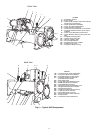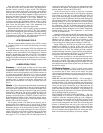8
Flow to the motor cooling system passes through an orifice
and into the motor. Once past the orifice, the refrigerant is
directed over the motor by a spray nozzle. The refrigerant
collects in the bottom of the motor casing and is then drained
back into the cooler through the motor refrigerant drain line.
An orifice (in the motor shell) maintains a higher pressure in
the motor shell than in the cooler. The motor is protected by a
temperature sensor imbedded in the stator windings. An
increase in motor winding temperature past the motor override
set point overrides the temperature capacity control to hold,
and if the motor temperature rises 10° F (5.5° C) above this set
point, closes the inlet guide vanes. If the temperature rises
above the safety limit, the compressor shuts down.
Refrigerant that flows to the oil cooling system is regulated
by thermostatic expansion valves (TXVs). The TXVs regulate
flow into the oil/refrigerant plate and frame-type heat exchang-
er (the oil cooler in Fig. 3). The expansion valve bulbs control
oil temperature to the bearings. The refrigerant leaving the oil
cooler heat exchanger returns to the chiller cooler.
VFD COOLING CYCLE
The unit-mounted variable frequency drive (VFD) is cooled
in a manner similar to the motor and lubricating oil cooling
cycle (Fig. 3).
If equipped with a unit-mounted VFD, the refrigerant line
that feeds the motor cooling and oil cooler also feeds the heat
exchanger on the unit-mounted VFD. Refrigerant is metered
through a thermostatic expansion valve (TXV). To maintain
proper operating temperature in the VFD, the TXV bulb is
mounted to the heat exchanger to regulate the flow of refriger-
ant. The refrigerant leaving the heat exchanger returns to the
cooler.
LUBRICATION CYCLE
Summary —
The oil pump, oil filter, and oil cooler make
up a package located partially in the transmission casing of the
compressor-motor assembly. The oil is pumped into a filter
assembly to remove foreign particles and is then forced into an
oil cooler heat exchanger where the oil is cooled to proper
operational temperatures. After the oil cooler, part of the flow
is directed to the gears and the high speed shaft bearings; the
remaining flow is directed to the motor shaft bearings. Oil
drains into the transmission oil sump to complete the cycle
(Fig. 4).
Details —
Oil is charged into the lubrication system through
a hand valve. Two sight glasses in the oil reservoir permit oil
level observation. Normal oil level is between the middle of the
upper sight glass and the top of the lower sight glass when the
compressor is shut down. The oil level should be visible in at
least one of the 2 sight glasses during operation. Oil sump tem-
perature is displayed on the CVC/ICVC (Chiller Visual Con-
troller/International Chiller Visual Controller) default screen.
During compressor operation, the oil sump temperature ranges
between 125 to 150 F (52 to 66 C).
The oil pump suction is fed from the oil reservoir. An oil
pressure relief valve maintains 18 to 25 psid (124 to172 kPad)
differential pressure in the system at the pump discharge. This
differential pressure can be read directly from the CVC/ICVC
default screen. The oil pump discharges oil to the oil filter as-
sembly. This filter can be closed to permit removal of the filter
without draining the entire oil system (see Maintenance sec-
tions, pages 71 to 75, for details). The oil is then piped to the oil
cooler heat exchanger. The oil cooler uses refrigerant from the
condenser as the coolant. The refrigerant cools the oil to a tem-
perature between 120 and 140 F (49 to 60 C).
As the oil leaves the oil cooler, it passes the oil pressure
transducer and the thermal bulb for the refrigerant expansion
valve on the oil cooler. The oil is then divided. Part of the oil
flows to the thrust bearing, forward pinion bearing, and gear
spray. The rest of the oil lubricates the motor shaft bearings and
the rear pinion bearing. The oil temperature is measured in the
bearing housing as it leaves the thrust and forward journal
bearings. The oil then drains into the oil reservoir at the base of
the compressor. The PIC II (Product Integrated Control II)
measures the temperature of the oil in the sump and maintains
the temperature during shutdown (see Oil Sump Temperature
Control section, page 36). This temperature is read on the
CVC/ICVC default screen.
During the chiller start-up, the PIC II energizes the oil pump
and provides 45 seconds of pre-lubrication to the bearings after
pressure is verified before starting the compressor. During
shutdown, the oil pump will run for 60 seconds to post-
lubricate after the compressor shuts down. The oil pump can
also be energized for testing purposes during a Control Test.
Ramp loading can slow the rate of guide vane opening to
minimize oil foaming at start-up. If the guide vanes open
quickly, the sudden drop in suction pressure can cause any re-
frigerant in the oil to flash. The resulting oil foam cannot be
pumped efficiently; therefore, oil pressure falls off and lubrica-
tion is poor. If oil pressure falls below 15 psid (103 kPad) dif-
ferential, the PIC II will shut down the compressor.
If the controls are subject to a power failure that lasts more
than 3 hours, the oil pump will be energized periodically when
the power is restored. This helps to eliminate refrigerant that
has migrated to the oil sump during the power failure. The con-
trols energize the pump for 60 seconds every 30 minutes until
the chiller is started.
Oil Reclaim System —
The oil reclaim system returns
oil lost from the compressor housing back to the oil reservoir
by recovering the oil from 2 areas on the chiller. The guide
vane housing is the primary area of recovery. Oil is also recov-
ered by skimming it from the operating refrigerant level in the
cooler vessel.
PRIMARY OIL RECOVERY MODE — Oil is normally re-
covered through the guide vane housing on the chiller. This is
possible because oil is normally entrained with refrigerant in
the chiller. As the compressor pulls the refrigerant up from the
cooler into the guide vane housing to be compressed, the oil
normally drops out at this point and falls to the bottom of the
guide vane housing where it accumulates. Using discharge gas
pressure to power an eductor, the oil is drawn from the housing
and is discharged into the oil reservoir.
SECONDARY OIL RECOVERY METHOD — The sec-
ondary method of oil recovery is significant under light load
conditions, when the refrigerant going up to the compressor
suction does not have enough velocity to bring oil along. Under
these conditions, oil collects in a greater concentration at the
top level of the refrigerant in the cooler. This oil and refrigerant
mixture is skimmed from the side of the cooler and is then
drawn up to the guide vane housing. There is a filter in this line.
Because the guide vane housing pressure is much lower than
the cooler pressure, the refrigerant boils off, leaving the oil be-
hind to be collected by the primary oil recovery method.


















